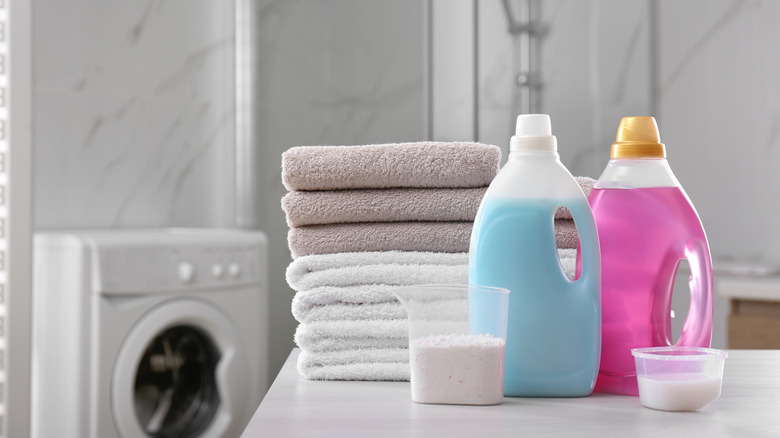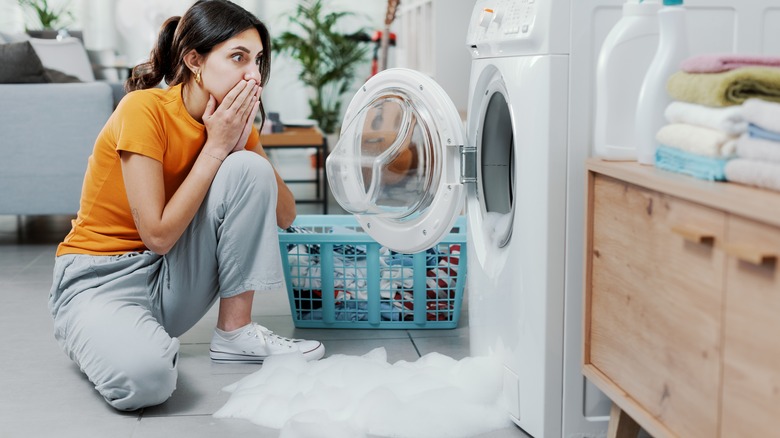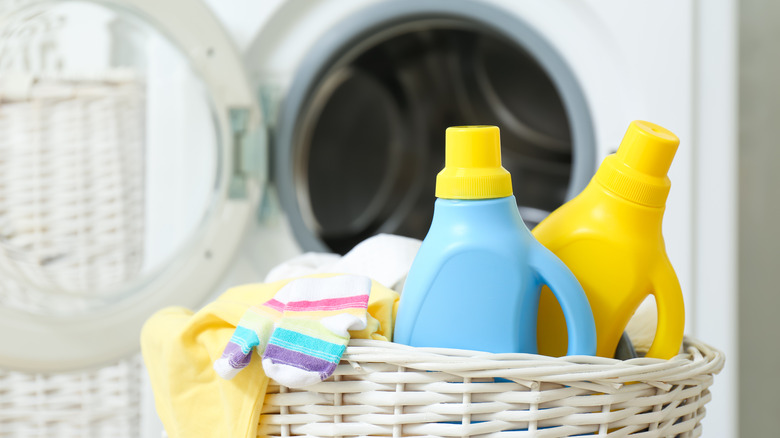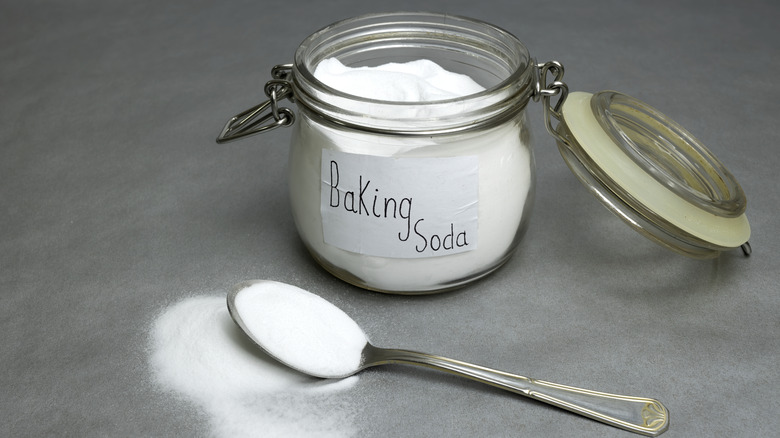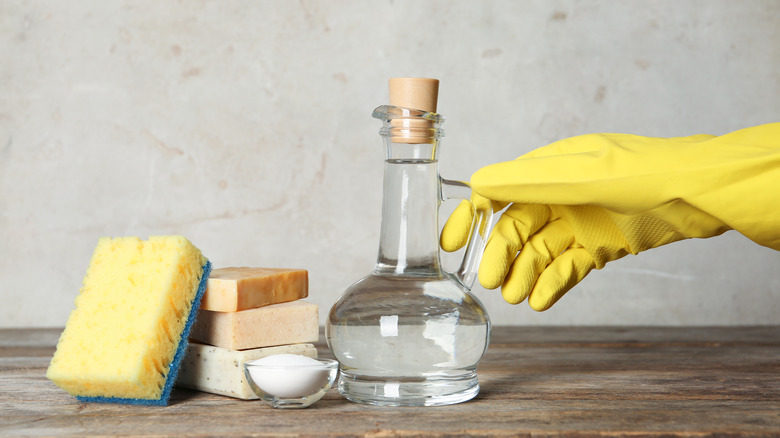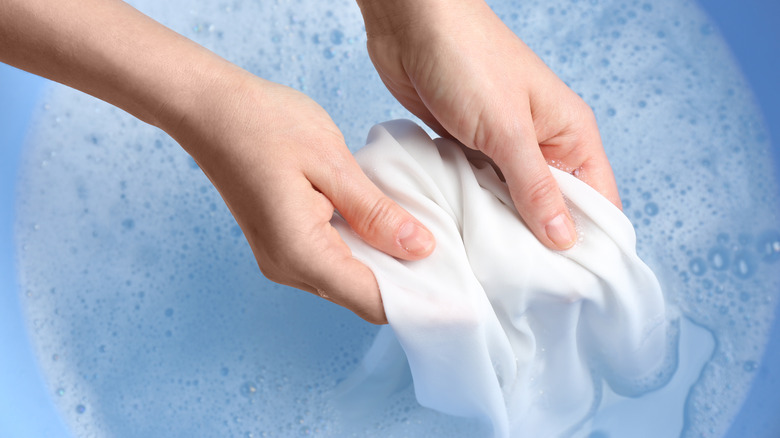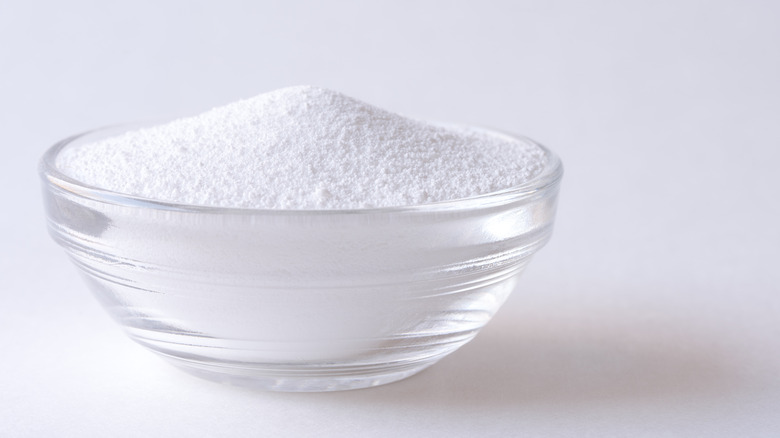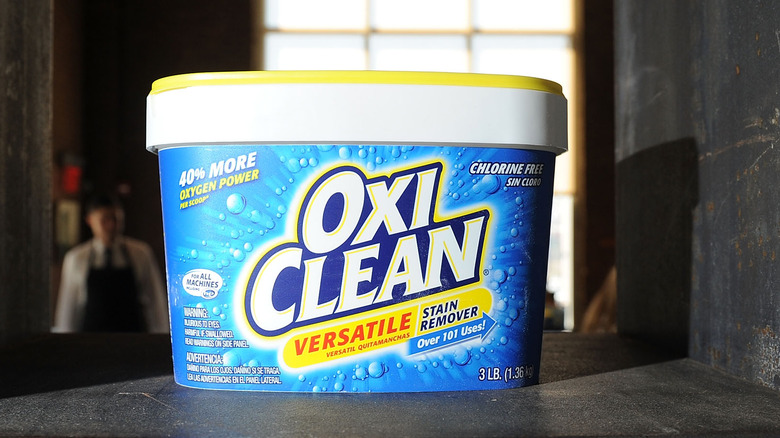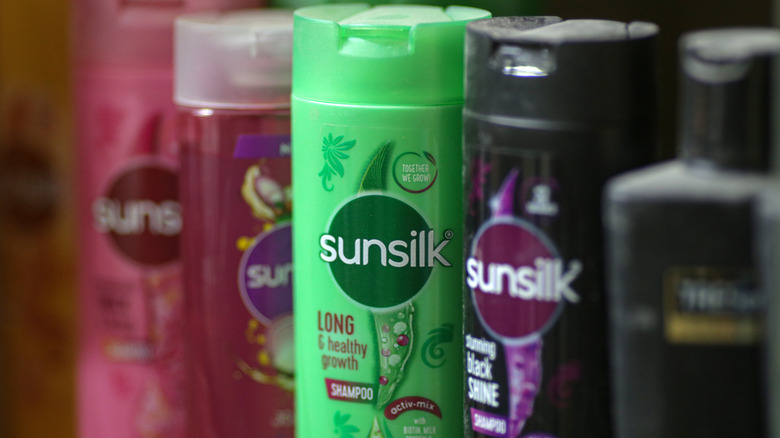Here's What You Can Substitute For Laundry Detergent
We've all been there: You walk into the laundry room ready to start a load, only to realize you're out of detergent. Even if it is too late to go to the store for more, you don't have to cut your chore short. Several items can serve as a stand-in for your favorite detergent until you get a chance to restock. And even better news, you probably have some of these items in your pantry or cleaning cupboard.
However, it is important to point out that you won't want to use many of these items on a regular basis. Laundry detergents are formulated specifically for the job of cleaning your clothes inside a washing machine. They're tough on dirt while gentle on fabrics and dyes, and sometimes DIY versions aren't as efficient. However, if you're in a real pinch, one of the items on the list below can help you avoid a catastrophe.
Never use these products in a washing machine
There are many products that should never be put in a washing machine. So, before we start looking at some possible laundry detergent substitutes, let's take a step back so you know what you should avoid using in its place. One of these products is dish soap. While it may seem like a logical substitute for detergent, adding dish soap to your washer can lead to disaster.
Just think about how much a few drops of soap foam up with a little water in the kitchen sink. Between how sudsy the soap is and the amount of water and agitation in a washing machine, the suds could spill over the sides of the washer, making a mess and leading to potential damage. This same reasoning applies to other soapy products designed to lather up and create bubbles, such as shampoo, bubble bath liquid, and body wash. Keep all of these far away from your washing machine.
Another important product that you should never add to your washer is dishwasher detergent. While this product is effective at cleaning your dishes, it is not designed for washing clothes. The formula for dishwasher detergent is not the same as laundry detergent and includes harsher ingredients. Adding it to your washer could leave a residue on your clothes or even cause them to become faded.
Fill your empty detergent bottle or box with water
Before you search high and low for a substitute, you might have enough detergent left in the bottle or box to clean one more load of laundry. If you're thinking, "But I dumped (or scooped) every last drop out; there's nothing left," you might want to think again. Enough detergent residue could be stuck to the sides of the container to clean that emergency load of laundry. Think about how thick liquid detergent is. It flows slowly and can really cling to the bottle.
The trick will be getting that last little bit out. To do this, you'll need a cup of warm water. Pour the water into the bottle, replace the lid, and shake it well. When you pour the water out into the washer, it will bring much of the stuck-on detergent from the sides of the bottle with it. If you have a box of powdered detergent, you can try pouring the water into the box, sloshing it around, and dumping the now soapy mixture into the machine. The good news is that it doesn't even take much detergent to clean a load of laundry. Because of the machine's agitation, you likely only need about 2 teaspoons if you're using a high-efficiency detergent.
Use baking soda
Baking soda is a versatile cleaning product. It can be used to clean grout and tile, dirty pots and pans, ovens, and, yes, even your laundry. It has deodorizing properties, which will help make sure that your clothes smell clean when they come out of the machine. Moreover, it is also an excellent stain fighter, so your clothes will not only smell fresh but also look great.
If you're going to add baking soda to your washer, add it directly to the barrel of the machine before you put in your clothes. You don't want to put it in the detergent tray because it may not dissolve during the cycle. Aim to use about 1/2 a cup for each load, or a little less if you're just washing a few items.
While baking soda is safe for your clothing, you'll still want to take a few steps to minimize the risk of damage. Turn all of the items inside out to protect the outside against fading. Then, set the machine to a delicate cycle using cold water to protect your fabrics further.
Add a little vinegar
Vinegar is another versatile cleaner you may have sitting in your pantry. One benefit of cleaning with this product is that it is natural and non-toxic. Unlike chemical cleaners with bleach, vinegar is much safer to use. In addition to helping you clean everything from glass to toilets to appliances, vinegar can also be used as a stand-in if you run out of detergent for a load of laundry. Either distilled white vinegar or apple cider vinegar would be best to use for cleaning clothes.
There are a few reasons why vinegar is an effective substitute. First, it can help loosen dirt and stains from your clothing, leaving them looking nice and clean after the cycle is complete. It is also an excellent odor remover and is hypoallergenic, making it a suitable alternative for people with sensitive skin. You also won't need to worry about vinegar staining your clothing. However, it is a good idea to add it to the washing machine drum and fill it with a little water before adding your clothing. This will dilute it enough to prevent its higher acidity levels from damaging your clothes.
Hand-wash with dish soap
While you should never put dish soap in your washing machine, it can be a suitable substitute for detergent if you want to hand-wash your clothes. Before you run to fill up your wash basin with soap and water, there are a few key pointers you'll want to understand. First, it only takes a little dish soap to clean laundry. Because of how sudsy it is, you'll only need about 1 teaspoon for each load. If you use too much, it could cause damage to the fabric or lead to your items getting waterlogged.
Next, the type of dish soap you use is important. Only use gentle, bleach-free formulas that won't compromise the integrity of your fabrics or cause discoloration. You will also want to avoid any lotion-based dish soaps or others with "special" ingredients. It is also important to only use cold water since hot water can lead to the formation of too many suds. Similarly, always thoroughly rinse each item after washing it. If you do not remove all of the soapy residue, it can leave your clothes feeling too stiff once they're dry.
Make your own detergent using Borax
You can combine Borax, washing soda, and a concentrated bar of soap to make laundry soap. While it's not identical to detergent, laundry soap can effectively clean clothing. It can be especially helpful in getting rid of stains from oil and grease. To make your own, you'll want to start by grating the soap bar — as if it were a block of cheese — over a large container.
Next, you'll want to combine the ingredients together. Work outside or in a well-ventilated area to do so. Measure out 1 cup of Borax and 1 cup of washing soda and combine them with the grated soap. Give all of the ingredients a good stir and close the lid to make sure the different powders settle before using it. You'll want to add about 2 tablespoons to the washing machine for each load. Take note that laundry soap should be used with warm water to ensure it dissolves properly. For this reason, it may not be the best substitute for any fabrics that can only be washed using cold water.
Add oxygen-based bleach
You can also use 1/2 cup of oxygen-based bleach to clean your clothes in a pinch. First, let's clarify: This is not the same thing as chlorine bleach, which should not be used as a detergent substitute because of its harshness. The active ingredient in oxygen-based bleach — also called color-safe bleach — is hydrogen peroxide, which works more gently to dissolve stains on your clothes. You can find color-safe bleaches in both powdered and liquid forms.
If you use oxygen-based bleach to clean a load of laundry, add it to the bottom of the washer before putting in your clothes. Do not pour it directly over your items, or you risk discoloring them. While you can use this product if you're out of options, you won't want to switch to it for everyday laundry cleaning. It works best alongside detergent rather than in its place.
Hand-wash using shampoo
If you're out of options and have a few clothing items you need to wash immediately, try using shampoo. Remember, shampoo is one of the products you should never put in your washing machine, so you'll have to hand-wash the garments that need cleaning. The rules for using shampoo to wash clothes are similar to those for using dish soap. To ensure it won't cause damage to any of your clothes, spot-test an inconspicuous area of the fabric before submerging each item in the sudsy basin.
The type of shampoo you choose is also important. Stay away from any formulas with conditioners since they may damage your fabrics. Similarly, you should avoid using shampoos specially formulated for colored or damaged hair. Instead, opt for a general, basic version, such as baby shampoo. Once you're done washing, ensure you thoroughly rinse the clothing so no leftover residue is embedded in the fabric. This can lead to soap scum and future damage.
